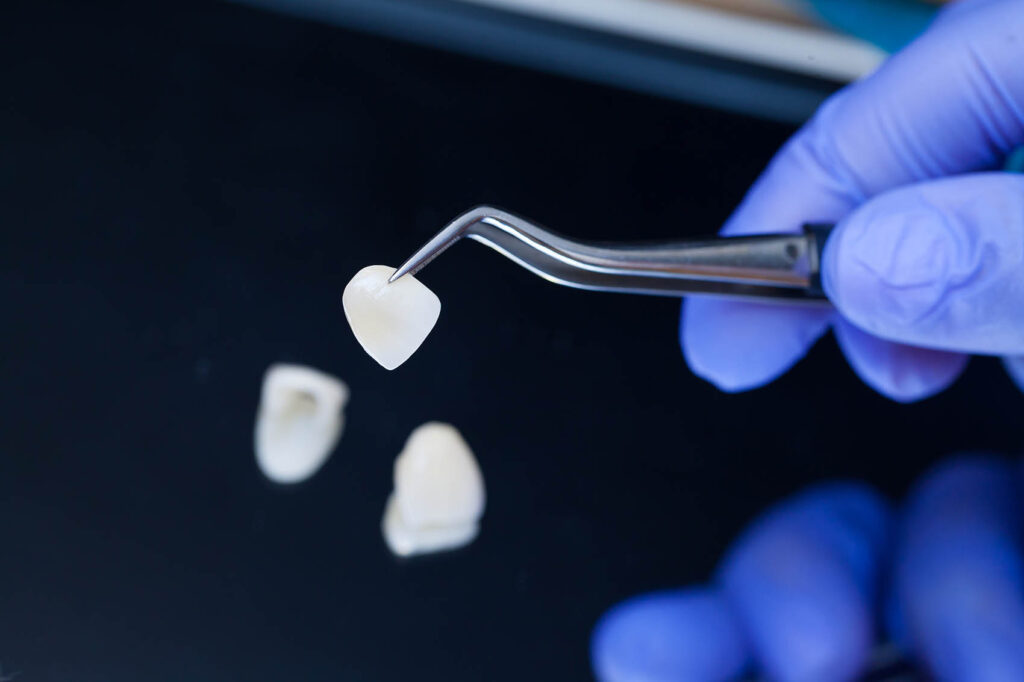When it comes to the art of cosmetic dentistry, veneers have paved the way to the perfect smile. These thin, custom-made shells, work wonders to cover the front surface of your teeth, hiding any imperfections to provide you with a smile you can wear with confidence. But like all good things, veneers do have a lifespan. The question that often lingers in the minds of those who’ve embraced this transformative treatment is: how often do they need a refresh? The good news is, veneers are considered a permanent solution that will continue to offer you the perfect smile for decades to come. But we’ll explore the signs that suggest it might be time to revisit your dentist and ensure that your veneers continue to achieve this desired look. Whether it’s natural wear and tear, changes in gum health, or the occasional accident, it’s important to recognise those rare moments when it’s time to consider a veneer replacement to help you maintain that picture-perfect smile.
Gums Are Pulling Back
Veneers sit over the top of your existing tooth structure, bonding seamlessly over your gums to create that radiant smile. The in-depth, well-thought-out process of porcelain veneers ensures their longevity. However, over time, you might notice your gums gently receding and pulling away from the veneer’s base.
Gum recession can expose the root of your tooth or the lower edge of the veneer, leading to potential sensitivity and change in appearance. This can also create small pockets that harbour bacteria. These areas can be challenging to clean effectively, increasing the risk of gum disease or further dental complications. It’s a reminder that while veneers offer a cosmetic solution, the health of the natural environment they reside in – the gums – is especially important.
If you notice your gums receding, it’s essential to consult with your dentist. Regular dental check-ups can monitor gum health, ensuring early intervention if any changes are detected.
Veneers Are Chipped or Cracked
Accidents are part and parcel of life. A knock, fall, ball to the face, biting into hard food, or some other unexpected event can lead to a chip or crack in your veneers. While veneers are extremely durable, they aren’t entirely immune to life’s unexpected twists and turns.
While a chipped or cracked veneer can take away from that picture-perfect smile, that’s not the only concern. Even a minor chip can expose the underlying tooth to external elements, making it susceptible to sensitivity or decay. Similarly, a crack, however small, can compromise the veneer’s structural integrity, risking further damage with continued wear.
It’s essential to address the issue promptly. Ignoring a damaged veneer can lead to more significant problems, both for the veneer itself and the tooth it protects. If you find yourself in the company of a chipped or cracked veneer, book an appointment with your dentist. They can assess your dental veneers and recommend the best course of action, whether it’s a simple repair or a replacement.
Feel Uncomfortable to Wear
While veneers can offer you that perfect smile you’ve been dreaming of, it shouldn’t come at a painful cost. Veneers should also feel comfortable and just like the original tooth itself. On rare occasions the bond between the existing tooth and your veneer can be disrupted, making the veneer begin to feel uncomfortable or out of place.
This discomfort can manifest in many different ways. It could be a slight edge that irritates the tongue, a feeling of tightness when you bite down, or even a sensation that something’s just not quite right. These feelings are signals from your mouth indicating that the veneer’s fit or position might have changed.
Several different things can contribute to this. The veneer could have shifted slightly from its original position, the underlying tooth might have undergone changes, or the gum line could have receded (as discussed above).
If your veneers start to feel uncomfortable, it’s time to revisit your dentist. With their expertise, they can assess the root cause of the discomfort, realigning, rebonding, or even replacing the veneer if necessary.
Underlying Tooth Is Decayed
Beneath the veneer lies your original tooth, which acts as an integral part of the veneer’s success. While veneers offer a protective shield for our teeth, decay can make its presence known out of sight, beneath the surface.
Initially, you might experience no symptoms. But as it progresses, there might be a sudden sensitivity to hot or cold, a dull ache that refuses to subside, or even a discolouration visible at the veneer’s edge.
Left unchecked, the decay can spread, putting not only the veneer but also the health of the tooth and surrounding gums at risk. It can lead to more significant dental complications, from root infections to gum disease.
If you suspect that the tooth beneath your veneer is decaying, it’s important to chat with your dentist. With their expertise, they can assess the extent of the decay, recommending treatments ranging from fillings to root canals. In some cases, the veneer might need to be temporarily removed to help with treatment.
Veneers Are Dark or Stained
Crafted to perfection, porcelain veneers are designed to resist the common staining agents that our natural teeth often fall prey to. However, over time, veneers might lose a bit of their lustre, appearing darker or showing stains that seem out of place.
So, what might be behind this unexpected discolouration? The answer often lies beneath the surface. While the veneer itself might resist external stains, the adhesive bonding it to the tooth can sometimes discolour, casting a shadow on the veneer and giving it a darker appearance. The underlying tooth might also change, either due to decay or other dental issues, which can reflect through the veneer.
Another potential culprit is exposure to certain foods. While veneers are resistant, they aren’t immune. Over time, repeated exposure can lead to slight discolouration, especially around the edges where the veneer meets the tooth.
A regular dental check-up can help monitor any changes in the veneer’s appearance, allowing for early intervention if needed. Professional cleaning can often alleviate surface stains, restoring the veneer’s shine.
Rough Around the Edges
Over time, veneers might start to show subtle signs of wear, and feel a tad rough around the edges. Over time, factors like natural wear, biting, or even the effects of certain foods and drinks, can cause these edges can become slightly rough or jagged.
In some cases, this might be due to minor chipping or wear of the veneer material itself. In others, it could be a result of the natural tooth enamel weaning away slightly. The bonding agent that secures the veneer to the tooth can also sometimes wear down, leading to tiny gaps at the veneer’s edge.
Rough edges can harbour plaque and bacteria, becoming a potential risk for gum irritation or even gum disease. If you find your veneers feeling rough around the edges, it’s important to see your dentist. They can assess the cause of the roughness and recommend appropriate action. Often, a simple polishing or re-contouring can restore the veneer’s smoothness. In cases where the bonding agent is compromised, a minor re-bonding procedure might be in order.
Book a Veneers Consult
Wondering if veneers are right for you? Check out our dental veneers in before and after pictures to see! Booking a veneer consultation is the first step in your tailored experience to bring out a smile you love. Our expert team at Dental + Skin Clinic can provide insights into the veneer process, the materials used, and the potential outcomes you can anticipate. Through digital imaging and mock-ups, we can help you visualise how veneers might enhance your smile, allowing you to make informed decisions with clarity and confidence. Book a veneers consultation today and dive deep into the world of cosmetic dentistry.



